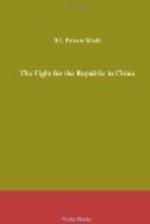The Japanese claim is based on the Treaty Respecting South Manchuria and Eastern Inner Mongolia signed in May, 1915, article 5 of which provides that civil and criminal cases in which the defendants are Japanese shall be tried and adjudicated by the Japanese consul.
The Chinese view is that this article is inapplicable to Koreans in this region and that the Tumen Kiang Agreement continues in force. This view is based on a saving clause in article 8 of the Treaty of 1915 which says that “all existing treaties between China and Japan relating to Manchuria shall, except where otherwise provided for by treaty, remain in force.”
In the first place, the origin of the Tumen Kiang Agreement supports this view. When the Japanese assumed suzerainty over Korea they raised certain questions as to the boundary between China and Korea. There were also outstanding several questions regarding railways and mines between China and Japan. Japan insisted that the boundary question and the railway and mining questions be settled at the same time. As a result, two agreements were concluded in 1909 one respecting the boundary question, the Tumen Kiang Agreement, and the other respecting railways and mines whereby Japan obtained many new and valuable privileges and concessions, such as the extension of the Kirin-Changchun Railway to the Korean frontier, the option on the Hsinminfu-Fakumen line, and the working of the Fushun and Yentai mines, while in return China obtained a bare recognition of existing rights, namely the boundary between China and Korea and the jurisdiction over the Koreans in the Yenchi region. The two settlements were in the nature of quid pro quo though it is clear that the Japanese side of the scale heavily outweighed that of the Chinese. Now Japan endeavours to repudiate, for no apparent reason so far as we can see, the agreement which formed the consideration whereby she obtained so many valuable concessions.
Secondly, while Koreans are now Japanese subjects, it is contended by the Chinese that the particular Koreans inhabiting the Yenchi region are, as regards China, in a different position from Japanese subjects elsewhere. These Koreans enjoy the rights of free residence and of cultivating and owning land in the interior of China, rights denied to other foreigners, including Japanese who, even by the new treaty, may only lease land in South Manchuria. For this exceptional privilege, they are subject to the jurisdiction of Chinese laws and Chinese courts, a duty not imposed on other foreigners. It would be “blowing hot and cold at the same time” in the language of English lawyers if it is sought to enjoy the special privileges without performing the duties.
Thirdly, Japanese under the Treaty of 1915 are required to register their passports with the local authorities. On the other hand, Koreans in Yenchi have never been nor are they now required to procure passports. This would seem to be conclusive proof that Koreans in that region are not within the provisions of the treaty of 1915 but are still governed by the Tumen Kiang Agreement.




